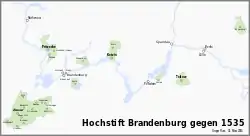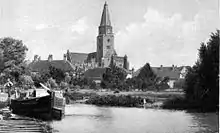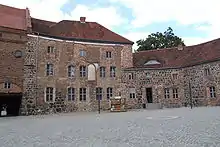Prince-Bishopric of Brandenburg
The Prince-Bishopric of Brandenburg (German: Hochstift Brandenburg) was an ecclesiastical principality of the Holy Roman Empire from the 12th century until it was secularized during the second half of the 16th century. It should not be confused with the larger Diocese of Brandenburg (Latin: Dioecesis Brandenburgensis) established by King Otto I of Germany in 948, in the territory of the Marca Geronis (Saxon Eastern March) east of the Elbe river. The diocese, over which the prince-bishop exercised only spiritual authority, was a suffragan diocese of the Archdiocese of Magdeburg, its seat was Brandenburg an der Havel.
Prince-Bishopric of Brandenburg Hochstift Brandenburg | |||||||||
|---|---|---|---|---|---|---|---|---|---|
| 1165–1598 | |||||||||
 Coat of arms
| |||||||||
 Episcopal territories, about 1535 | |||||||||
| Status | State of the Holy Roman Empire | ||||||||
| Capital | Brandenburg an der Havel Ziesar (residence) | ||||||||
| Common languages | Brandenburgisch, Polabian | ||||||||
| Religion | Roman Catholic until the 1530s, then Lutheran | ||||||||
| Government | Elective monarchy, ruled by the bishop holding the see, elected by the cathedral chapter or, exceptionally, appointed by the Pope, or ruled by a regent | ||||||||
| Prince-Bishop, or Regent | |||||||||
• 1173–1179 | Prince-Bishop Sigfrid I | ||||||||
• 1421–1459 | Prince-Bishop Stephan | ||||||||
• 1560–1569 | Regent John George | ||||||||
• 1569–1571 | Regent Joachim Frederick | ||||||||
| Historical era | Middle Ages | ||||||||
• Diocese founded and restored | 948 1161 | ||||||||
• Territorial reign est. | 1165 | ||||||||
• De facto supremacy of Electoral Brandenburg | 1373 | ||||||||
• Electors privileged to choose candidates for the see | 1447 | ||||||||
• Secularised as part of Electoral Brandenburg | 1571 | ||||||||
• Legal dissolution | 1598 | ||||||||
| Currency | rixdollar | ||||||||
| |||||||||
The Prince-Bishopric of Brandenburg was an imperial estate of the Holy Roman Empire for some time, probably starting about 1161/1165. However, the Brandenburg bishops never managed to gain control over a significant territory, being overshadowed by the Margraviate of Brandenburg, which was originally seated in the same city. Chapter and cathedral, surrounded by further ecclesiastical institutions, were located on the Dominsel (Cathedral Island), which formed a prince-episcopal cathedral immunity district (Domfreiheit), distinct from the city of Brandenburg. Only in 1929 the - meanwhile former - immunity district was incorporated into the city itself.
History

The foundation charter of the Brandenburg diocese is dated 1 October 948, though the actual founding date remained disputed among historians. The medieval chronicler Thietmar of Merseburg mentions the year 938; the bishopric may also have been established in the course of the partition of the vast Marca Geronis and the emergence of the Northern March after Margrave Gero's death in 965. With the foundation, King Otto (Holy Roman Emperor from 962) aimed at the Christianization of the Polabian Slavs (Wends) and the incorporation of their territory into the East Frankish realm.
Brandenburg was originally a suffragan of the Archbishopric of Mainz, but in 968 it came under the jurisdiction of the Magdeburg archbishops. The Great Slav Rising of 983 practically annihilated it, when revolting Lutici tribes conquered Brandenburg and the neighbouring Bishopric of Havelberg. Brandenburg bishops continued to be appointed, but they were merely titular, residing in Magdeburg or acting as auxiliary bishops in the western territories of the Empire. Not until the final subjugation of the Wends in the 12th century by Margrave Albert the Bear, the German eastward settlement (Ostsiedlung) in the diocesan region revived the bishopric.
Bishop Wigers of Brandenburg (acting 1138–60), an adherent of Norbert of Xanten, was the first of a series of bishops of the Premonstratensian Order, which chose the occupants of the episcopal see until 1447; in that year a bull of Pope Nicholas V gave the right of nomination to the Brandenburg elector, with whom the bishops stood in a close feudal relation. Bishop Wigers also established a Premonstratensian convent at Leitzkau (today part of Gommern, Saxony-Anhalt). Probably at the request of the Hevellian prince Pribislav-Henry, he established another convent at the Slavic Parduin settlement in present-day Brandenburg an der Havel, which became the nucleus of the revived Brandenburg cathedral chapter. The incorporation into the Premonstratensian Order was confirmed by Pope Clement III in 1188.

As rulers of imperial immediacy, regnant in a, however, dispersed territory partitioned into the four bailiwicks (German: Ämter) of Brandenburg/Havel, Ketzin, Teltow and Ziesar. The prince-bishops from the early 14th century onwards resided in their fortress in Ziesar on the road to Magdeburg. The last actual bishop was Matthias von Jagow (d. 1544), who took the side of the Protestant Reformation, married, and in every way furthered the undertakings of the Hohenzollern elector Joachim II.
There were two more nominal bishops, but on the petition of the latter of these, the electoral prince John George of Brandenburg appointed in 1560, the secularisation of the bishopric was undertaken and finally accomplished in 1571, in spite of legal proceedings to reassert the imperial immediacy of the prince-bishopric within the Empire and so to likewise preserve the diocese, which dragged on into the 17th century.
Bishops of Brandenburg
- 949–968: Dietmar
- 968–980: Dodilo
- 980–1004: Volkmar
- 992–1018: Wigo
- 1022–1032: Luizo
- 1032-1048: Rudolf
- 1048–1051: Dankwart
- 1068–1080: Dietrich I
- 1080–1092: Volkmar II
- 1100–1122: Hartbert
- 1124–1137: Ludolf
- 1137–1138: Landbert
Prince-bishops
- 1138–1160: Wiggar
- 1160–1173: Wilman
- 1173–1179: Sigfried I
- 1179–1190: Baldran
- 1190–1192: Alexius
- 1192–1205: Norbert
- 1205–1216: Baldwin
- 1216–1220: Siegfried II
- 1221–1222: Ludolf von Schanebeck, claimant, but not enthroned
- 1221–1222: Wichmann von Arnstein, counter-claimant, also not enthroned
- 1222–1241: Gernot
- 1241–1251: Rutger von Ammendorf
- 1251–1261: Otto von Mehringen
- 1261–1278: Heinrich I von Osthenen (or Ostheeren)
- 1278–1287: Gebhard
- 1287–1290: Heidenreich
- 1290–1291: Richard, refused the appointment
- 1291–1296: Dietrich, not enthroned
- 1296–1302: Vollrad von Krempa
- 1303–1316: Friedrich von Plötzkau
- 1316–1324: Johann I von Tuchen
- 1324–1327: Heinrich II Count of Barby, not enthroned
- 1327–1347: Ludwig Schenk von Reindorf (or Neuendorf)
- 1347–1365: Dietrich II Kothe
- 1366–1393: Dietrich III von der Schulenburg
- 1393–1406: Heinrich III von Bodendiek (or Bodendieck)
- 1406–1414: Henning von Bredow
- 1414: Friedrich von Grafeneck, Prince-Bishop of Augsburg 1413–1414
- 1415–1420: Johann von Waldow, Bishop of Lebus 1420–1423
- 1420: Friedrich von Grafeneck, again
- 1421–1459: Stephan Bodecker
- 1459–1472: Dietrich IV von Stechow
- 1472–1485: Arnold von Burgsdorff
- 1485–1507: Joachim I von Bredow
- 1507–1520: Hieronymus Schulz (or Scultetus), Bishop of Havelberg 1521–1522
- 1520–1526: Dietrich V von Hardenberg
Lutheran bishops
- 1526–1544: Matthias von Jagow
- 1544–1546: Sede vacante
- 1546–1560: Joachim of Münsterberg-Oels
- 1560-1569/71: John George of Brandenburg, regent (Verweser)
- 1569/71: Joachim Frederick of Brandenburg
Secularized and merged into Brandenburg.
References
 This article incorporates text from a publication now in the public domain: Jackson, Samuel Macauley, ed. (1914). New Schaff–Herzog Encyclopedia of Religious Knowledge (third ed.). London and New York: Funk and Wagnalls. Missing or empty
This article incorporates text from a publication now in the public domain: Jackson, Samuel Macauley, ed. (1914). New Schaff–Herzog Encyclopedia of Religious Knowledge (third ed.). London and New York: Funk and Wagnalls. Missing or empty |title=(help)
